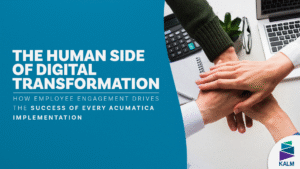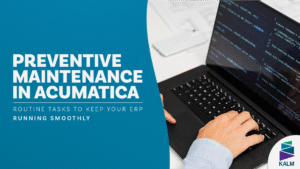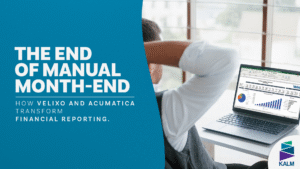More in Common Than You Think
You wouldn’t walk into a dealership and say “I need a car” without knowing what for, how much you’ll spend, or which features matter.
Yet many companies approach ERP implementations with the same lack of clarity—leading to slow performance, frustrated users, and costly do-overs.
The truth is, selecting and implementing an ERP is not just about buying software. It’s about knowing your business journey, mapping the road ahead, and ensuring you have the right vehicle to get there.
Let’s explore how the process of buying a car perfectly mirrors planning a successful ERP implementation—and why getting specific is the key to real optimization.
Define Your Destination Before Choosing the Vehicle
Purpose is everything.
When shopping for a car, you ask:
- Will I commute daily, go off-road, or need space for a family?
- Do I care more about speed, safety, or fuel economy?
- Am I driving solo or carrying passengers?
With an ERP, the same questions apply:
- Will this system handle HR, finance, logistics—or all three?
- What core business challenges should it solve?
- Who will use it, and how?
Without clarity, you risk buying a two-seater convertible when what you needed was a heavy-duty delivery van.
Example:
A distribution company implemented an ERP without defining scope. They chose a system optimized for accounting but weak in inventory. Within months, warehouse staff were frustrated, stockouts increased, and the company had to spend again on custom modules—doubling the budget.
Lesson: Just like knowing whether you need a city car or a pickup truck, defining your ERP’s purpose up front avoids painful mismatches.
Go Beyond the Base Model: Features That Fuel Your Business
You can drive a base model off the lot—but do you want to?
Car buyers consider:
- Backup cameras, sunroofs, GPS, leather seats
- Warranty, fuel type, tech packages
ERP buyers should think the same way:
- What dashboards and reports are essential?
- Which automations can replace manual tasks?
- Do you need integrations with CRM, eCommerce, or payroll tools?
Not all ERPs come with bells and whistles—some features must be chosen, designed, or customized.
Example:
A service company deployed an ERP “as is” without setting up dashboards. Managers had to export raw data into Excel just to track KPIs. After KALM optimized their environment with automated dashboards, reporting time dropped by 80%, freeing managers to act instead of preparing data.
Lesson: Don’t accept the base model if your business journey demands more horsepower.
Plan for the Long Haul: Maintenance, Support, and Future-Proofing
With cars, it’s not just about the purchase—it’s about long-term cost and reliability.
Smart buyers ask:
- How often does it need service?
- Are parts expensive? Are upgrades a nightmare?
- What’s the total cost of ownership over five years?
ERP requires the same foresight:
- Will customizations break during updates?
- Is support local, responsive, and scalable?
- Will it grow with your company or require a rebuild in three years?
Example:
A mid-size manufacturer heavily customized its ERP without considering updates. Every upgrade broke integrations, causing weeks of downtime. After re-implementing with standardized tools, maintenance costs dropped and upgrades became seamless.
Lesson: Your ERP must be future-proof—not a lemon in disguise.
Map Your Route: The Implementation Roadmap, Budget, and Team
Buying a car comes with:
- Financing, insurance, taxes, test drives, trade-ins
Implementing an ERP comes with:
- Licensing, consulting, training, data migration, downtime planning
You need:
- A realistic timeline
- Clear stakeholder roles
- A roadmap for a phased rollout or big-bang launch
Example:
A company rushed its ERP implementation in four months to “save costs.” They skipped proper training and data cleanup. Within weeks of go-live, errors piled up, productivity sank, and employees reverted to spreadsheets. The savings disappeared in emergency consulting fees.
Lesson: Rushing an ERP is like driving off the lot without insurance or a license—you’re asking for trouble.
🚦 ERP vs. Car Buying: A Side-by-Side Look
| Car Buying Question | ERP Equivalent |
|---|---|
| What type of car do I need (sedan, SUV, truck)? | What business areas will the ERP cover (finance, HR, logistics)? |
| Which features matter most (safety, GPS, luxury)? | Which modules, dashboards, and automations are essential? |
| What’s the total cost of ownership? | What’s the full cost of licensing, support, and upgrades? |
| Is the dealer reliable and nearby? | Is the ERP vendor or consultant experienced and accessible? |
| Can I upgrade or customize later? | Can the ERP scale with my business and integrate with other systems? |
| What’s included in the warranty? | What support, training, and maintenance are guaranteed? |
This side-by-side framework makes one thing clear: an ERP is not just a purchase—it’s a long-term commitment.
How to Test-Drive Your ERP Before Buying
Nobody buys a car without a test drive. ERP should be no different.
Here’s how to test-drive your ERP:
- Pilot Programs: Run the system with a small department to identify issues before full rollout.
- User Demos: Let actual end-users—not just IT—explore workflows. Their feedback reveals gaps early.
- Scenario Testing: Simulate real-life cases: closing the books, running payroll, or processing a large order.
- Integration Checks: Ensure the ERP connects smoothly with CRM, eCommerce, or warehouse systems.
- Vendor Support Test: Call support during trial—measure responsiveness before you commit.
Lesson: If the ERP doesn’t feel right during the test drive, it won’t magically improve after go-live.
Top 5 Mistakes When Choosing an ERP (and Their Car-Buying Equivalent)
- Not defining requirements clearly
- Car: Buying a sports car when you needed a minivan.
- ERP: Choosing a system great at finance but useless for supply chain.
- Ignoring total cost of ownership
- Car: Only looking at the sticker price, not fuel, insurance, or maintenance.
- ERP: Only budgeting for licenses, ignoring consulting, updates, and training.
- Skipping the test drive
- Car: Buying without a test drive.
- ERP: Not running pilot tests or demos with real users.
- Over-customizing
- Car: Adding unnecessary modifications that void the warranty.
- ERP: Over-customizing instead of using standard modules—making upgrades impossible.
- Forgetting the long-term journey
- Car: Choosing a two-door coupe when you plan to start a family.
- ERP: Buying for today’s needs without planning for growth in 3–5 years.
Real-World Scenarios You’ll Recognize
The CEO Who Underestimated Costs
Attracted by a low license price, the CEO approved ERP implementation without factoring in consulting, training, or hidden costs. Within a year, the “cheap” ERP had cost twice the original estimate. With the right planning, they could have budgeted realistically and avoided surprise overruns.
The IT Manager Who Skipped the Test Drive
Confident in technical specs, the IT Manager signed off on ERP without piloting real workflows. Once live, the system failed to integrate with CRM, forcing employees to double-enter data. The company lost months correcting what a short demo could have revealed.
The HR Director Who Needed Scalability
Initially, payroll was the only requirement. But as the company grew, HR needed talent management, onboarding, and performance tracking. Because the ERP was chosen without scalability in mind, the organization had to migrate again after just three years.
👉 If any of these scenarios sound familiar, your ERP strategy might need more than a tune-up—it might require a complete roadmap.
It’s Time to Turn Your Data into Your Strongest Asset
Data on its own is just noise. Its value emerges when structured, contextualized, and presented to illuminate the road ahead.
Choosing an ERP is like choosing a car—you wouldn’t hit the highway without a vehicle built for the journey ahead. With the right approach, ERP is not just software—it’s the engine of your organization’s growth.
At KALM Consulting, we help companies choose, plan, and optimize ERP so it becomes a reliable vehicle for long-term success. From discovery workshops to full implementation and optimization, we make sure your ERP is built for the road ahead.
Don’t leave your ERP journey to chance.
👉 Book a free ERP strategy consultation with KALM today and let’s put your business in the fast lane.








